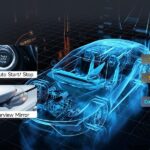A Car Scanner Code Reader, also known as an OBD scanner, has become a must-have tool for any home mechanic. These devices allow you to read engine fault codes, enabling you to diagnose and fix problems in modern cars and vans without needing a costly trip to a professional mechanic. This guide will explain why owning a car scanner code reader is crucial for saving money and maintaining your vehicle.
OBD scanners provide the quickest way to troubleshoot car issues. Without one, you’re forced to visit a garage where labor rates can easily exceed $50 per hour. A car scanner code reader, paired with a reliable online repair guide, empowers you to diagnose and resolve most common faults and electrical problems yourself, using simple tools and saving significant money. While there are many different car scanner code readers available, ranging from basic models to those with advanced features, they all share the core functionality of reading and clearing diagnostic trouble codes.
What is a Car Scanner Code Reader?
A car scanner code reader is a handheld diagnostic computer that connects to your car’s onboard computer system to retrieve fault codes. Prices can range from under $15 to hundreds of dollars. While high-end models offer additional features, all car scanner code readers should, at a minimum:
- Communicate with the vehicle’s computer
- Read fault codes
- Clear fault codes
It’s important to note that most basic car scanner code readers won’t reset service lights or oil life monitors, including ABS and SRS systems. For these tasks, you’ll need to consult a more comprehensive repair guide or specialized software.
How OBD Works
OBD stands for On-Board Diagnostics. All gasoline passenger cars sold since 2001 and diesel cars sold since 2004 are equipped with an OBD-II port. This 16-pin port, resembling an old TV SCART socket, allows the car scanner code reader to communicate with the vehicle’s computer. The OBD-II port itself provides power to the scanner, eliminating the need for batteries or external power sources. Located under the dashboard, usually on the driver’s side, the OBD-II port is the gateway to understanding your car’s health.
Choosing the Right Car Scanner Code Reader
Selecting the right car scanner code reader depends on your needs and budget. Basic code readers are sufficient for reading and clearing codes, providing a starting point for DIY repairs. More advanced scanners offer features like live data streaming, allowing you to monitor sensor readings in real-time, and specific functionalities tailored to certain car makes. Understanding your needs will help you determine the level of sophistication required in your car scanner code reader.
Conclusion
Investing in a car scanner code reader is a smart decision for any car owner. This essential tool empowers you to diagnose car problems, saving you time and money on potentially expensive garage visits. From basic code reading to advanced diagnostics, a car scanner code reader puts you in control of your car’s maintenance and repair.

